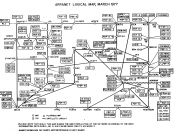Today we have the opportunity to reach any part of the world and any information we can possibly imagine all at our fingertips. The creation of the Internet was an amazing and an arduous process by a collaboration of many different people and companies. Many innovative ideas have served as the stepping stone which now rests as a gigantic pyramid of the Internet, which has yet to have reached its pinnacle.
One could argue that the creation of the Internet was made in part by the Sputnik scare in the early 19601s. Fears that were aroused made the military take guard and build up technological forces. The United States thought that it would need a networking system without an obvious center to attack so that it could survive a nuclear war. Thus the Internet assumed its identity in 1969 by the Advanced Research Projects Agency which became known as ARPANET. The ARPANET was a system of nodes that were able to send information to one another. These nodes allowed one computer to receive information from another computer. The first four nodes were known as the ARPANET. Later during the 19601s more researchers use the Internet to connect the time-sharing computers.
From 1970-1973 the Internet already becomes a big hit. The computers that are hooked up on a large network become popular for its e mail application. More hosts on the Internet grow and after 1971 the number reaches 23. During 1973, APRANET first becomes international with connections to the University of College in London, England and the Royal Radar Establishment in Norway. Starting from 1974 the Internet moves more away from its former military purposes and becomes more used for public purposes. In 1974, Bolt, Beranek and Newman open Telnet which was the first commercial version of ARPANET. More popularity grows from the Internet as popular people begin using it. Queen Elizabeth writes the first royal e mail message in 1976. In 1979, students at Duke University make the first USENET newsgroups which allowed people to have discussion groups regarding politics, religion, and many other subjects.
After the 701s finish the 801s start out with even more popularity for the Internet. The amount of hosts in 1981 was 213. The 801s contributed to many outstanding breakthroughs for the Internet. For example from 1982-1987 Bob Kahn and Vint Cerf create TCP/IP which became the programming language for Internet computers. The connection of all the networks becomes more known as the Internet instead of ARPANET as time progresses. By 1984 the number of hosts exceeds 1,000 which continues to rise and by 1987 the number of hosts reach 10,000. By 1988 the Internet becomes so big that the first concerns for privacy and security come up. Hackers and crackers appear which sometimes lowered the amount of security on the Internet. In 1988, a program known as the 3Internet Worm2 is released which disabled 10% of the hosts on the Internet. The Computer Emergency Response Team (CERT) which dealt with possible solutions to security concerns on the Internet. By the end of the decade the amount of hosts was over 100,000.
By the 19901s companies using Internet are slapped with commercial regulation, but by 1991 the NSF quickly removes all of its restrictions. Mark MaCahill invents the point and click method that is now apparent in our Internet. He states that its 3the first Internet application my mom can use2. Hypertext is conceived of which allows pictures, sounds, and words to be used at the same time which a great breakthrough. By 1992 the first audio and video broadcasts are made through the Internet. The number of hosts has now risen to 1,000,000. As the Internet grows the traffic does as well, which expands at a 341,634% per year. A new programming language called Javascript is also introduced in 1995. The new programming language allows materials accessed in the Internet to be seen in a completely different light. By 1996, about 40 million people are connected to the Internet and the number of hosts approaches 10 million. As the past few years have come around the Internet has become a main source of communication and information. It has emulated the uses of the library in research and can even sometimes provide as a good substitute.
As the Internet continues to take off, one can only imagine in the next decade what kind of further advances will be made in the Internet. So many changes have happened in the past decade and the history of the Internet itself has unfolded many mysterious in a short period of time. The growth of the Internet has grown at an exponential ratio and seems as though it will continue to do so, but who knows what the next century will bring and what further advances the human mind will make (www.pbs.org).


